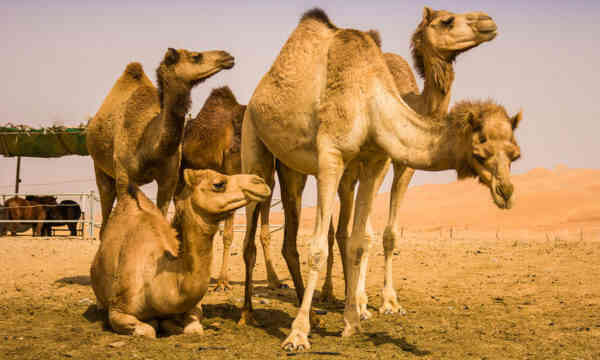The amazing animals camels are well adapted to the arid regions of our planet, and they survive where most other animals do not will last longer than a couple of days. Thanks to their endurance, camels have long been considered a measure of wealth among many peoples, and to this day they have not lost their significance in many parts of the Earth.
Interesting facts about camels
- An adult camel can weigh up to 700-800 kg.
- Thick camel hair reflects sunlight and protects these animals from the scorching heat.
- Due to their sharp eyesight, camels are able to distinguish the slightest movement at a distance of up to a kilometer even on a sunny day in the desert (interesting facts about deserts).
- On the fat reserves stored in the hump, a camel can last up to a month without food and water.
- These animals smell a source of water for 50-60 kilometers, unmistakably finding oases.
- Due to the special structure of the camel nose, the moisture exhaled along with the steam returns back to the body
- In the United Arab Emirates, camel races are held, and the riders are not people, but robots, compact and equipped with speakers so that the owner can cheer on your camel (interesting facts about the UAE).
- During a dust storm, camels squeeze their nostrils tightly, blocking them so that sand does not get into their nose.
- Camel saliva smells just terrible, because when they spit, they spit not just saliva, but gastric fluid.
- Arabs have used camels as fighting animals for many centuries. Unlike horses, they are more easily frightened and rush to run, but horses do not survive in the desert.
- Rough camel lips allow them to calmly eat desert thorns without fear of injury.
- Camels are two-humped and single-humped. The latter are called dromedaries.
- These animals were domesticated so long ago that they are almost gone in the wild. Wild bactrian camels are now found only in Chinese and Mongolian nature reserves (interesting facts about Mongolia).
- Even an experienced driver cannot make a camel stand up if he decides to lie down and rest.
- Camels can go without water for so long because the red blood cells in their blood are unique – thanks to their special form, camel blood does not lose fluidity even with a lack of moisture in the body.
- During the daytime, the camel’s body temperature rises by 6-7 degrees to keep him cool and sweat.
- Camel’s milk is much more nutritious than cow’s milk. At the same time, it contains almost no lactose.
- Camels have two rows of eyelashes instead of one. This density of cilia helps them protect the eyes more reliably from sand.
- Camels drink water faster than any other living creature. And at one time he is able to absorb up to 150-180 liters of water, which will later be converted by his body into fatty tissue in the humps.
- Translated from Arabic, the words «camel» means «beauty».
- In a number of African countries, camels are considered sacred animals, like a cow in India (interesting facts about India).
- These animals usually show aggression only during competition with other males for a female.
- Due to the special structure of the soles of the feet, flat and wide, camels do not fall into loose hot sand.
- They can kick with each of their legs in all directions. A horse, for example, can only kick forward with its front foot, and only backward with its back foot.
- Dehydration in the body of a camel begins only after the loss of a quarter of all the water contained in its body, not counting the reserves in the humps.
- Most of the moisture they need comes from plants.
- Camel dung is so dry that Bedouin nomads use it as fuel for fires.
- Despite the humps, the spine of camels is perfectly straight.
- They only begin to sweat when their body temperature exceeds 41 degrees. The norm for them is 40-41 degrees during the day and 34-35 at night.
- A huge number of wild, or rather, feral camels are found in Australia. They were brought there a long time ago, and since then they have fairly bred (interesting facts about Australia).
- Despite the fact that they can go without food for a long time, with available vegetation, a camel can absorb 30-40 kg of food per day.
- In cooler regions, camels grow a lush mane for the winter, which thins in spring and shortens again in length.
- There are now about 20 million camels in the world. But only approximately – for obvious reasons, it is impossible to count exactly.
- These animals are great swimmers, despite the fact that they usually live where there are almost no water bodies.
